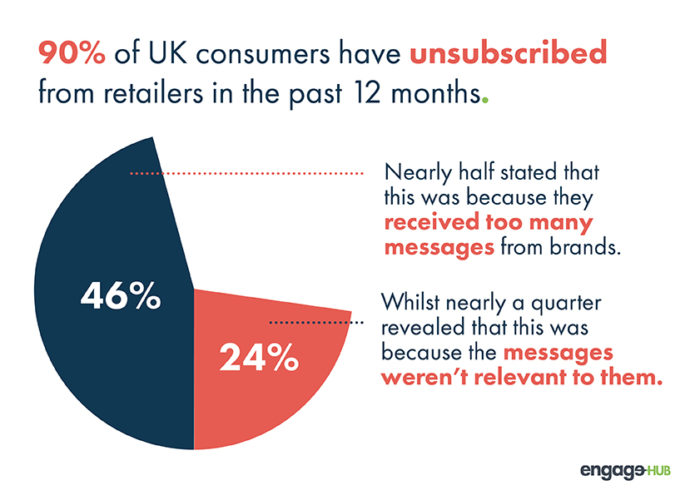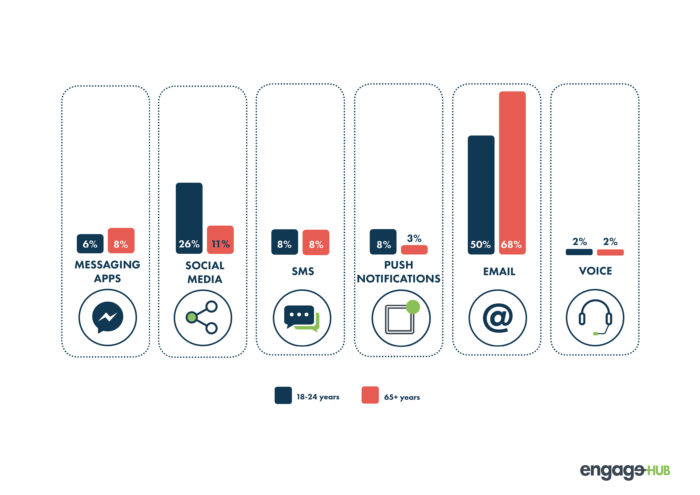It’s official – poorly targeted and overly frequent digital communications from retailers are turning consumers off. Statistics show a staggering amount of people unsubscribe or simply ignore messages that are so often littering their inboxes, the recipients deciding they are email overkill . . . spam. What’s to be done?
Email marketing has been around for a long, long time. It all started when Gary Thuerk, a marketer for Digital Equipment Corporation, sent out an email promoting DEC computers to a mass audience in 1978. From the 400 emails sent, the company saw sales of $13 million for DEC machines – triggering a lot of excitement around a new channel of communication for the marketing industry.
40 years on, and marketers are still seeing email as a critical channel for building relationships between a brand and their customers. It’s clear to see why; email marketing can deliver messages to consumers quickly and at scale. It drives results – online revenue, app downloads and event registration – to the point where retailers are now feeling the pressure to send even more emails to their subscribers. These days, it’s reported that more than half send at least three emails to their customers every week.
Too much of a good thing? 
Unfortunately, consumers are starting to get a bit fed up with the number of messages they are receiving from brands. Recent research conducted by Engage Hub found that 90 per cent of UK consumers have unsubscribed from communications from retailers in the past 12 months, with nearly half saying this is because they received too many messages from brands. In fact, nearly of quarter of UK consumers say they receive communications from some retailers at least once every day, while 15 per cent said they receive offers even more frequently than that.
But it’s not just the frequency of messages that’s making customers unhappy, it’s the content itself. Nearly a quarter (24%) said they unsubscribed from a retailer because the messages they received were irrelevant to them. What’s more, more than one in ten respondents said retailers never send them offers or updates that are relevant to them.
Far from just simply annoying consumers, this constant bombardment of irrelevant communications will have a significant impact for retailers, given that one in ten UK consumers would consider shopping elsewhere if they continued to receive spam from a company.
Therefore, it’s time to put an end to ‘spray and pray’ style marketing. Poorly targeted campaigns generate the most spam complaints, and the majority of such communications remain unopened or in the trash folder. This not only undermines a retailer’s spend on direct marketing ROI but it also turns customers away as they quickly become disengaged and frustrated with a brand that doesn’t treat them as an individual.
The personal touch
Marketers need to turn their attention to harnessing real-time data to drive more meaningful, memorable and effective conversations with customers. Crafting contextual, highly personalised content that draws the customer in is critical at a time when loyalty is at an all-time low.
And it’s what customers are calling for. Nearly half of UK consumers said they would be more encouraged to click through to purchase if promotional offers were tailored to their likes and dislikes. What’s more, one fifth said they would also be more encouraged to click through to purchase if offers were sent to them via their preferred channel of communication.

The research found that email was considered the channel of choice for the majority of UK consumers (62%), yet nearly one in five (17%) would most like to receive communications from retailers via social media – making this the second most popular channel for UK consumers. But there are notable differences for some key demographics – whereas considerably more (68%) aged 65 or older prefer communications via email than those aged between 18 and 24 (50%). Social media is the preferred communication channel for 26% of that younger age group, but only 11% of those aged 65+.
While email is considered the most preferred channel for the majority of consumers, it’s becoming clear that the younger demographic is increasingly shifting preference to less traditional means of communication. Social media, for example, was identified by a significant number of 18 to 24-year-olds as a channel they’d most like to receive communications from retailers.
Choosing the right channel to engage with consumers is as big a factor as the content of a message itself, and that needs to be based on insight into customer preferences. This level of personalisation in customer engagement goes a long way towards building and reaffirming the customer-brand relationship.
Making data meaningful
This is where leveraging data, from transactions and interactions that customers have already had with a brand, proves invaluable.
Today, companies have access to more customer information than ever before. However, if you can’t transform it into actionable customer insights, the data’s value diminishes considerably. Another problem is that few companies have a single system that orchestrates multiple campaigns for every department and enterprise customer. This means there is very little control over when and how often customers are contacted.
Therefore, retailers need to look into bringing real time demographic data, location triggers and behavioural information into a single platform to enable marketers, customer services and IT teams to work together. Only then can they better manage information and ensure content is highly personal to the individual customer at every turn. What’s more, it’s important that companies gain a holistic view of subscribers by consolidating CRM data and marketing activity across multiple channels, with unified messaging rules to ensure consumers don’t feel like they are being bombarded.
Email overkill: stop the spam
There can be no denying that email marketing is a hugely important tool for marketers. Recent research revealed that nearly one in five marketers identified the channel as delivering the highest ROI. As such, more than half said they would increase email marketing budgets in 2017.
This is all very well, but consumers are getting tired of their inboxes filling up with irrelevant comms. They will not hesitate to unsubscribe or go to a competitor if they feel they are not being treated as an individual. To make the most of their investments, retailers now need to start delivering personalised and highly targeted information via a customer’s preferred channel of communication in order to cut through the noise and boost engagement.
Modern marketing is all about taking valuable customer data and using it to deliver the right information, at the right time to the right person, through the right channel, on the right platform. The opportunity is there for the taking, so it’s time for retailers change tact today.
Have an opinion on this article? Please join in the discussion: the GMA is a community of data driven marketers and YOUR opinion counts.
Read also:
Emailers: 7 things you need to know about the opt-out process
Insight into the email marketing trends that are shaping 2017








Leave your thoughts